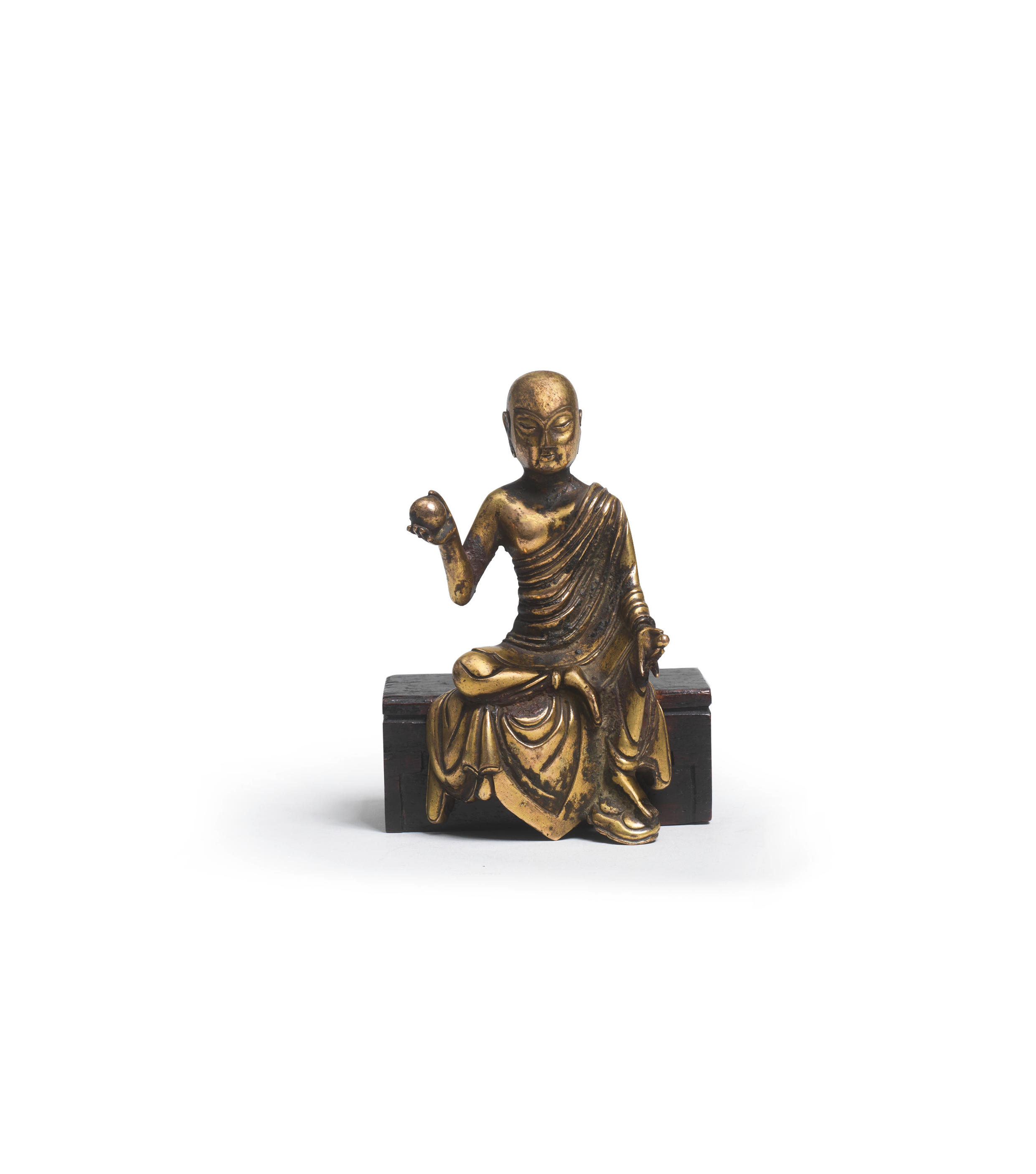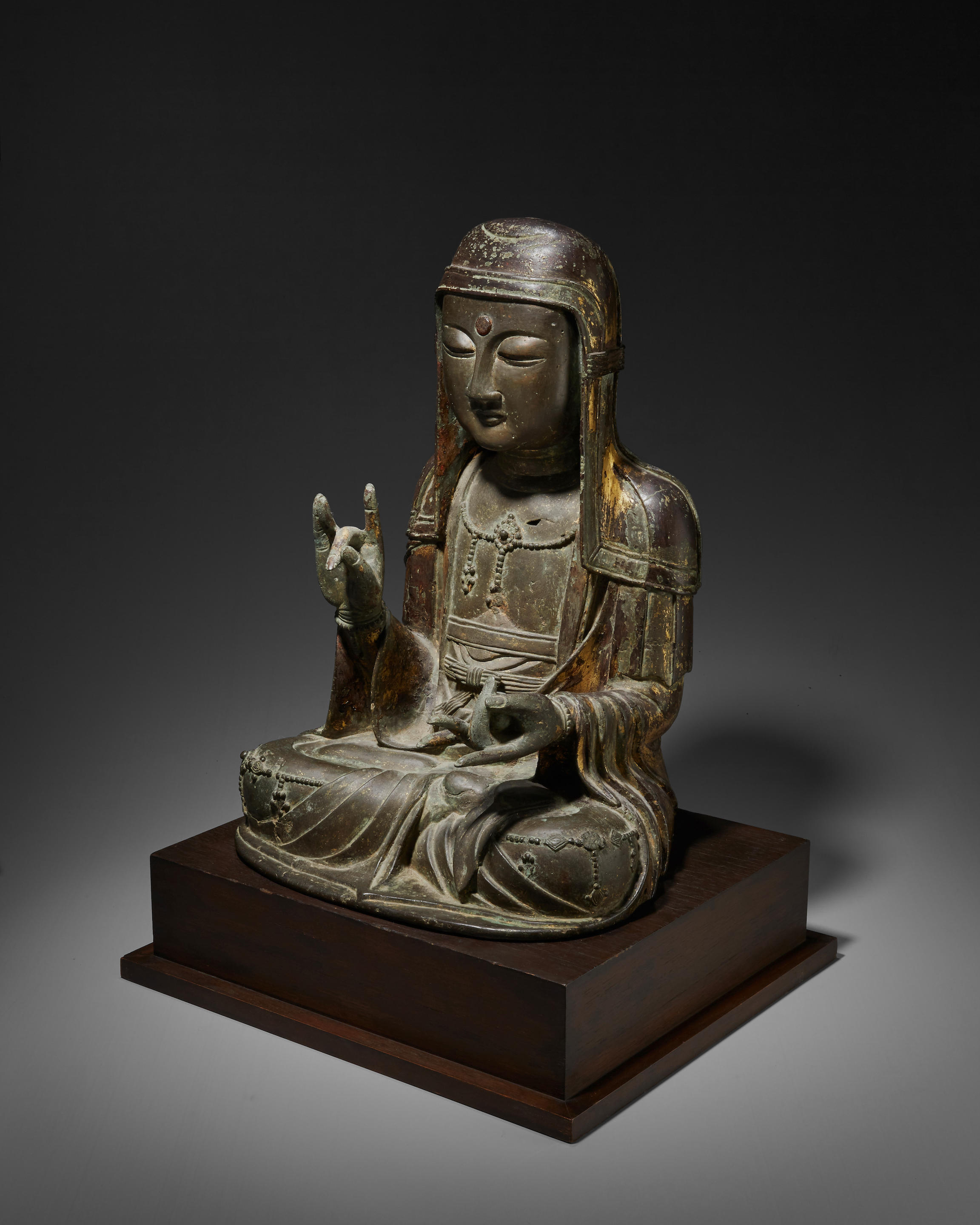China, early Ming Dynasty, 15th century, probably Yongle (1403-1424) or Xuande (1426-1435) period. Of tapering form surmounted by a short neck and a galleried ‘monk’s cap’ rim, applied with two strap handles, each terminating in large, imposing ruyi-heads, supported on a tall spreading foot with lipped rim. Provenance: A French estate. An Austrian collector, acquired from the above. Condition: Very good condition with some wear, minor dents and nicks, occasional light scratches, wear to gilt, traces of red pigment. Over half a millennium, the bronze has naturally grown into an even, olive-green patina with a lustrous shine and an unctuous overall feel. Weight: 4,710 g Dimensions: Height 62.5 cm ‘Monk's cap’ ewers owe their origin to the close relations between Tibet, Mongolia and China during the Song period. It is believed that the earliest ewers in this distinctive shape were made of bronze or wood, and porcelain examples are found in Yuan and early Ming contexts. The form of a monk’s cap that may have provided the model for these ewers is uncertain, but Tibetan priests such as Deshin Shekpa, or Shakya Yeshe (1354-1435), the representative of Tsongkhapa, who was sent on his behalf to the Yongle court, are usually depicted wearing a stiff black headdress with a staggered outline, which could be compared to the rims of these ewers. The Yongle Emperor ordered significant quantities of porcelain sacrificial vessels of this shape to be made at the imperial kilns for the ceremonies conducted by the Tibetan hierarchs, particularly those undertaken in honor of the emperor's deceased parents in 1407. Monk’s cap ewer production continued into the Xuande period in new colors, motifs, and decoration. One of the most notable innovations of the ‘monk’s cap’ ewer in the Xuande period is the blue and white ewer. After the Xuande period, production of the ‘monk’s cap’ ewer came to a halt for over two-hundred years, only to reappear in the early Qing dynasty, when they were revered by emperors for their unusual shape and superb quality. Expert’s note: The strict, almost exaggerated form of the present ewer mirrors its model, the headdress of Shakya Yeshe (1354-1435), who served at the Yongle court, with its characteristic, staggered outline and oversized fender above the handle being the most prominent representatives of this innovative, highly distinct design. Likewise, tribute was paid to the early Ming emperors by applying similarly imposing, oversized Ruyi emblems at both ends of the handles. Overall, this vessel is a fastidious testimonial to the close relations between Tibet and China during the Yongle and Xuande reigns, its massive shape emphasizing the stability and peace gained from harmonizing these two cultures, so different in nature. Having lost their significance, these features were quickly eliminated on revival pieces from later periods, their replacements being commercially more successful decorations, such as dragons, floral borders, and the like. Literature comparison: For the early 15th-century prototype, compare the red-glazed covered ewer in the Palace Museum, Beijing, illustrated in the revised Sekai Toji Zenshu, vol. 14, Japan, 1976, pl. 32. For a related example in parcel-gilt silver from the Potala Palace Collection, see Treasures from Snow Mountains - Gems of Tibetan Cultural Relics, Shanghai Museum, 2001, p.180, no.91. Compare with a tianbai-glazed monk’s cap ewer from the Yongle period, at Christie’s Hong Kong, in Imperial Collection of Chinese Ceramics from a Private Collector, on 27 November 2019, lot 2921, sold for HKD 1,875,000. Compare also with a cloisonné and gilt-bronze monk’s cap ewer dated to the early Ming dynasty, at Sotheby’s Hong Kong in Important Chinese Art on 11 July 2020, lot 3626, bought-in at an estimate of HKD 20,000,000-30,000-000. Compare also with a revival monk’s cap ewer from the 19th century, at Christies New York on 15 March 2016, lot 283, sold for USD 18,750. 漢藏包金僧帽壺 中國,明初,十五世紀,可能爲永樂 (
China, early Ming Dynasty, 15th century, probably Yongle (1403-1424) or Xuande (1426-1435) period. Of tapering form surmounted by a short neck and a galleried ‘monk’s cap’ rim, applied with two strap handles, each terminating in large, imposing ruyi-heads, supported on a tall spreading foot with lipped rim. Provenance: A French estate. An Austrian collector, acquired from the above. Condition: Very good condition with some wear, minor dents and nicks, occasional light scratches, wear to gilt, traces of red pigment. Over half a millennium, the bronze has naturally grown into an even, olive-green patina with a lustrous shine and an unctuous overall feel. Weight: 4,710 g Dimensions: Height 62.5 cm ‘Monk's cap’ ewers owe their origin to the close relations between Tibet, Mongolia and China during the Song period. It is believed that the earliest ewers in this distinctive shape were made of bronze or wood, and porcelain examples are found in Yuan and early Ming contexts. The form of a monk’s cap that may have provided the model for these ewers is uncertain, but Tibetan priests such as Deshin Shekpa, or Shakya Yeshe (1354-1435), the representative of Tsongkhapa, who was sent on his behalf to the Yongle court, are usually depicted wearing a stiff black headdress with a staggered outline, which could be compared to the rims of these ewers. The Yongle Emperor ordered significant quantities of porcelain sacrificial vessels of this shape to be made at the imperial kilns for the ceremonies conducted by the Tibetan hierarchs, particularly those undertaken in honor of the emperor's deceased parents in 1407. Monk’s cap ewer production continued into the Xuande period in new colors, motifs, and decoration. One of the most notable innovations of the ‘monk’s cap’ ewer in the Xuande period is the blue and white ewer. After the Xuande period, production of the ‘monk’s cap’ ewer came to a halt for over two-hundred years, only to reappear in the early Qing dynasty, when they were revered by emperors for their unusual shape and superb quality. Expert’s note: The strict, almost exaggerated form of the present ewer mirrors its model, the headdress of Shakya Yeshe (1354-1435), who served at the Yongle court, with its characteristic, staggered outline and oversized fender above the handle being the most prominent representatives of this innovative, highly distinct design. Likewise, tribute was paid to the early Ming emperors by applying similarly imposing, oversized Ruyi emblems at both ends of the handles. Overall, this vessel is a fastidious testimonial to the close relations between Tibet and China during the Yongle and Xuande reigns, its massive shape emphasizing the stability and peace gained from harmonizing these two cultures, so different in nature. Having lost their significance, these features were quickly eliminated on revival pieces from later periods, their replacements being commercially more successful decorations, such as dragons, floral borders, and the like. Literature comparison: For the early 15th-century prototype, compare the red-glazed covered ewer in the Palace Museum, Beijing, illustrated in the revised Sekai Toji Zenshu, vol. 14, Japan, 1976, pl. 32. For a related example in parcel-gilt silver from the Potala Palace Collection, see Treasures from Snow Mountains - Gems of Tibetan Cultural Relics, Shanghai Museum, 2001, p.180, no.91. Compare with a tianbai-glazed monk’s cap ewer from the Yongle period, at Christie’s Hong Kong, in Imperial Collection of Chinese Ceramics from a Private Collector, on 27 November 2019, lot 2921, sold for HKD 1,875,000. Compare also with a cloisonné and gilt-bronze monk’s cap ewer dated to the early Ming dynasty, at Sotheby’s Hong Kong in Important Chinese Art on 11 July 2020, lot 3626, bought-in at an estimate of HKD 20,000,000-30,000-000. Compare also with a revival monk’s cap ewer from the 19th century, at Christies New York on 15 March 2016, lot 283, sold for USD 18,750. 漢藏包金僧帽壺 中國,明初,十五世紀,可能爲永樂 (













.jpg)
Testen Sie LotSearch und seine Premium-Features 7 Tage - ohne Kosten!
Lassen Sie sich automatisch über neue Objekte in kommenden Auktionen benachrichtigen.
Suchauftrag anlegen